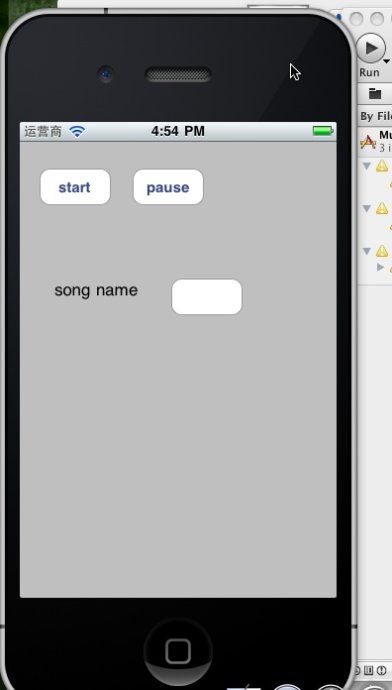AVAudioPlayer播放音乐,最清晰明了
在xcode中手动添加frameWork。
#import "MusicViewController.h"
#import <AVFoundation/AVFoundation.h>
#import <AudioToolbox/AudioToolbox.h>
@implementation MusicViewController
@synthesize start;
@synthesize pause;
@synthesize restart;
@synthesize BT1;
@synthesize player;
-(IBAction)tostart:(id)sender{
[player play]; //播放
AudioSessionSetActive (true);
}
-(IBAction )topause:(id)sender{
[self.player pause];
AudioSessionSetActive (false);//要引入tool包才行,不然报错
}
- (void)dealloc
{
[BT1 release];
[super dealloc];
}
- (void)didReceiveMemoryWarning
{
// Releases the view if it doesn't have a superview.
[super didReceiveMemoryWarning];
// Release any cached data, images, etc that aren't in use.
}
#pragma mark - View lifecycle
// Implement viewDidLoad to do additional setup after loading the view, typically from a nib.
- (void)viewDidLoad
{
NSString * musicFilePath = [[NSBundle mainBundle] pathForResource:@"audio" ofType:@"mp3"]; //创建音乐文件路径
NSURL * musicURL= [[NSURL alloc] initFileURLWithPath:musicFilePath];
AVAudioPlayer * thePlayer = [[AVAudioPlayer alloc] initWithContentsOfURL:musicURL error:nil];
//创建播放器
self.player = thePlayer; //赋值给自己定义的类变量
[musicURL release];
[thePlayer release];
[player setVolume:1]; //设置音量大小0-1之间
player.numberOfLoops = -1;//设置音乐播放次数 -1为一直循环
[super viewDidLoad];
}
- (void)viewDidUnload //内存警告时才会释放,当前的viewController即使出现内存警告,也不会unload
{
[self setBT1:nil];
[super viewDidUnload];
// Release any retained subviews of the main view.
// e.g. self.myOutlet = nil;
}
- (BOOL)shouldAutorotateToInterfaceOrientation:(UIInterfaceOrientation)interfaceOrientation
{
// Return YES for supported orientations
return (interfaceOrientation == UIInterfaceOrientationPortrait);
}
@end
------------------------------------------------------------------
运行出来效果(这个就是你在IB里面以绑定事件就行)
PS:这里有几个问题需要说明以下
1. 这个[player play] 和【player pause】 时AVAudioPlayer自带的方法,默认情况下你暂停后,再play他会接着你刚才那个继续放,原因时这个play再这个view没有被dealloc之前 ,对象一直没有被销毁。
2.使用slider 当音控调教装置
代码很简单
-(IBAction) volumeChange:(id) sender{
self.player.volume = volumebar.value;
}
/////////////////////////////////////////////
iPhone应用轻松使用AVAudioPlayer音频播放是本文要介绍的内容,iPhone SDK中的AVFoundation框架包括的AVAudioPlayer是一个容易使用而且功能强大,基于Object-c的播放音频文件播放器 。本教程展示了怎样使用AVAudioPlayer 。本教程将建立一个简单的程序,它能够循环播放一段mp3音频文件 。
源代码/Guithub
教程的源代码在GitHub上 。你可以从仓库中克隆或直接下载zip文件 。
创建项目
启动Xcode并创建一个“View-Based iPhone application”项目,取名为AudioPlayer:
1.从Xcode菜单选择“File > New Project …”
2.从“iPhone OS > Application”部分选择“View-based Application”,然后按“Choose…”
3.将项目命名为“AudioPlayer”并按“Save”
添加AVFoundation框架
为使用SDK的AVAudioPlayer类,我们需要将AVFoundation框架加入项目:
1.在项目的“Groups & Files”面板上,展开“Targets”
2.Control+点击或右击AudioPlayer
3.选择“Add > Existing Frameworks…”
4.点击Linked Libraries下左下方的+按钮
5.选择“AVFoundation Framework“并按Add
6.“AVFoundation framewoks”将出现在“Linked Libraries”下,关闭窗口
下面,我们将引入AVFoundation的头文件
1.展开项目“Group & Files”面板下AudioPlayer项目
2.打开Classes文件夹
3.选取AudioPlayerViewController.h进行编辑
4.更改文件 。更改以下粗体字部分:
- #import <UIKit/UIKit.h>
- #import <AVFoundation/AVFoundation.h>
- @interface AudioPlayerViewController : UIViewController
- {
- AVAudioPlayer *audioPlayer;
- }
- @end
添加音频文件
我们需要一段音频文件来进行播放 。文件为audiofie.mp3 。我们将其加入项目中:
按Control再左击或右击项目的“Group & Files”面板中的“Resources”文件夹
从上下文菜单中选取“Add > Existing Files…”
找到并选择要导入的音频文件,按“Add”
(有必要的话)选定“Copy items into destination group’s folder”方框并按“Add”
开始播放音频
1.解除ViewDidLoad方法的注解
2.更改如下,见粗体部分:
- - (void)viewDidLoad
- [super viewDidLoad];
- NSURL *url = [NSURL fileURLWithPath:[NSString
- stringWithFormat:@"%@/audiofile.mp3", [[NSBundle mainBundle] resourcePath]]];
- NSError *error;
- audioPlayer = [[AVAudioPlayer alloc] initWithContentsOfURL:url error:&error];
- audioPlayer.numberOfLoops = -1;
- if (audioPlayer == nil)
- NSLog([error description]);
- else
- [audioPlayer play];
AVAudioPlayer是通过URL初始化的,所以我们首先要创立一个指向资源文件夹中音频文件的URL 。将音频播放器的numberOfLoops属性设为负数使得播放无限循环 。配置好音频播放器后,我们向播放器对象发送播放消息来启动播放 。
记住在dealloc方法中释放audioPlayer 。改变见粗体部分:
- - (void)dealloc
- [audioPlayer release];
- [super dealloc];
- }
更多功能
你可以调节播放器音量,查看/设定播放的时间,暂停或停止播放:
- audioPlayer.volume = 0.5; // 0.0 - no volume; 1.0 full volume
- NSLog(@"%f seconds played so far", audioPlayer.currentTime);
- audioPlayer.currentTime = 10; // jump to the 10 second mark
- [audioPlayer pause];
- [audioPlayer stop]; // Does not reset currentTime; sending play resumes
最后,你还可以实现AVAudioPlayer Delegate协议,比如说,在音频播放结束时得到通知,这样你有可能移动到播放列表的下一首歌 。
然后自己把事件一绑定就行
/////////////////////////////////////
另一篇更详细的文章,见:http://www.oschina.net/question/213217_40638
